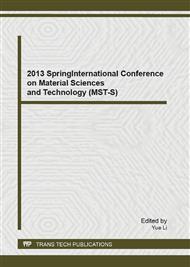[1]
J. Giboz, T. Copponnex, P. Mele, Microinjection molding of thermoplastic polymers: a review, J. Micromech. Microeng. 17 (2007) 96–109.
DOI: 10.1088/0960-1317/17/6/r02
Google Scholar
[2]
A. Griffiths, Moulding the world, Materials World. 14 (2006) 35-36.
Google Scholar
[3]
E.F. James, Analyzing explosive of the next generation transparency(NGT), Proceedings of the 1997 35th Annual Symposium Safe Association. (1997) 138-141.
Google Scholar
[4]
Z. Chen, X. Qian, Y.F. Jin, Shrinkage and defect analysis of HDPE thick part, Eng. Plast. App. 38 (2010) 33-35.
Google Scholar
[5]
C.Y. Khor, Z.M. Ariff, F. Che Ani, Three-dimensional numerical and experimental investigations on polymer rheology in meso-scale injection molding, Int. Comm. Heat. Mass.Tran. 37 (2010) 131-139.
DOI: 10.1016/j.icheatmasstransfer.2009.08.011
Google Scholar
[6]
H.S. Lee, Y.G. Yoo, Effects of Processing Conditions on Cavity Pressure during Injection-Compression Molding, Int. J. Precis. Eng. Manuf. 13 (2012) 2155-2161.
DOI: 10.1007/s12541-012-0286-x
Google Scholar
[7]
S.Y. Yang, Y.C. Chen, Experimental Study of Injection-Charged Compression Molding of Thermoplastics, Adv. Poly. Tech. 17 (1998) 353-360.
DOI: 10.1002/(sici)1098-2329(199824)17:4<353::aid-adv6>3.0.co;2-q
Google Scholar
[8]
W.S. Guan, H.X. Huang, Back melt flow in injection-compression molding: Effect on part thickness distribution, Int. Comm. Heat. Mass.Tran. 39 (2012) 792-797.
DOI: 10.1016/j.icheatmasstransfer.2012.04.012
Google Scholar
[9]
S.H. Chen, Y.C. Chen, N.T. Chen, Simulations and Applications of Injection-Compression Molding, J. Rein. Plast. Comp. 18 (1999) 724-734.
Google Scholar
[10]
B. Fan, D.O. Kazmerk, Simulation of injection-compression molding for optical media, Poly. Eng. Sci. 43 (2003) 596-606.
Google Scholar
[11]
H.X. Huang, Fiber Orientation In Injection-Compression Molded Short-Fiber-Reinforced Polypropylene Parts, Proceedings of the ASME 2009 International Mechanical Engineering Congress & Exposition. (2009)
DOI: 10.1115/imece2009-13174
Google Scholar
[12]
W.S. Guan, H.X. Huang, B.Wang, Poiseuille/Squeeze Flow-Induced Crystallization in Microinjection-Compression Molded Isotactic Polypropylene, J. Poly. Sci: PART B: Poly. Phys. (2012)
DOI: 10.1002/polb.23218
Google Scholar
[13]
Y.C. Li, B. Zhu, Y.S. Zhang, Depth Contraction and Optical Distortion for Transparent Plastic Plate, Plastics. 38 (2009) 108-110.
Google Scholar
[14]
Y.H. Chen, Y. Yuan, Y.S. Zhang, X. Li, M.S. Zhan, Residual Stresses,Warpage and Shrinkage Analysis of Injection Molded Transparent Panel Based on Optical Distortion, J. Aero. Mater. 28 (2008) 82-87.
Google Scholar


